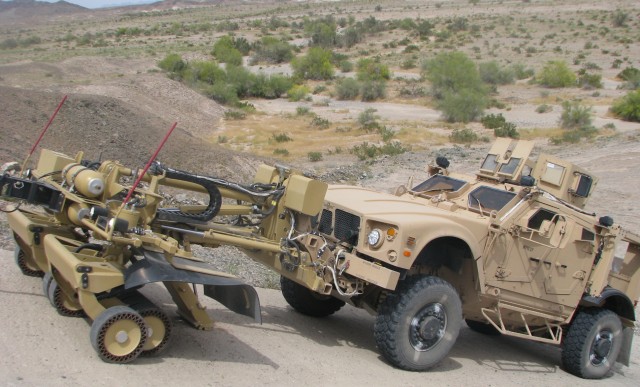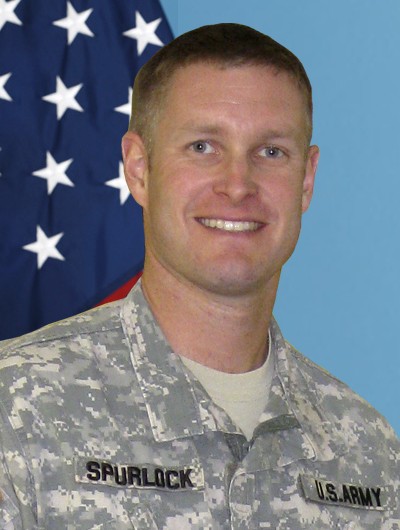PICATINNY ARSENAL, N.J. -- Long hours, hectic schedules and extensive training - this was the norm for a Picatinny military officer during a recent six-month deployment to Afghanistan.
Maj. Brian Spurlock of the Project Manager Combat Ammunition Systems, Program Executive Office for Ammunition, who safely returned to Picatinny in November, was the forward-deployed operations officer for all PEO Ammunition products in Afghanistan.
During his deployment, he helped field more than 2.4 million rounds of the Army's new 5.56 mm bullet, the Enhanced Performance Round, as well as hundreds of Improvised Explosive Device-Defeat products to troops.
During Spurlock's deployment, he worked with the U.S. forces Afghanistan staff, which is in charge of overseeing all the equipment that goes in and out of Afghanistan. His role was to oversee all of PEO Ammunition's equipment fieldings that took place during his deployment and to manage the Field Service Representatives (FSR) supporting the PEO mission.
Field Service Representatives are civilian contractors hired by the program offices to field equipment to Soldiers and teach them how to properly and safely employ the technology.
This was Spurlock's first time to Afghanistan, although he has deployed to Iraq twice as an artillery officer. And while he had overseen equipment fieldings in his prior assignment to the 155 mm lightweight howitzer program, this was also Spurlock's first fielding outside the continental U.S., or OCONUS.
"(CONUS fieldings are) very structured," Spurlock said about equipment fieldings in the United States. "Units know almost six months in advance if they're going to be getting something. And then when you do the fielding here, you have a classroom environment and it's very scripted and organized."
Fieldings are less structured in a war theater due to the hectic environment of combat zones, he said.
To get the equipment to troops, it is often sent directly from the manufacturer to the deployed unit.
"Sometimes the roads between where we were set up and they were set up, were too dangerous to put Soldiers on the road to pick up a piece of equipment. So it was easier and safer to get it to them either by air or other means and then fly FSRs to them," Spurlock said.
Sometimes Spurlock only oversaw the delivery of products, such as the Self-Protection Adaptive Roller Kit. SPARK consists of roller banks that attach to the front of a vehicle to roll ahead of the vehicle and detonate IEDs that are commonly buried beneath roads.
Many units had SPARKs that had encountered IEDs, so the FSRs were replacing those that had been destroyed.
Combat units also needed equipment training on other products, which could take anywhere from an hour to a week, depending on the technical nature of the product.
Spurlock said the most difficult part of his deployment was asking himself at the end of the day, "Did I really do everything I could today to get the guys the equipment that could save their lives'"
That is also a question engineers and program managers here at Picatinny should ask themselves each day, Spurlock said.
"Because of the nature of these products-they save Soldiers lives-everybody in the program can help cut down the fielding time," he said of materiel enterprise goals.
After spending six months working with Soldiers in a combat zone, Spurlock also suggested that engineers and program offices think more about various aspects of continuous improvement.
Engineers need to ask themselves what they can do to shorten the time it takes to field equipment, as well as how they can make a system easier for a Soldier to understand and use, he said.
GRATITUDE EXPRESSED
While Spurlock's deployment was difficult for his family, he thanked the Picatinny community for reaching out to his family while he was away.
Lt. Col. Brian Bosworth, director of the Munitions Engineering Technology Center within the Armament Research Development and Engineering Center, and Chris McDermott, a golf professional at the Picatinny Golf Club, took one of Spurlock's sons to the 2010 Barclays Golf Tournament.
"At a place like Picatinny Arsenal, which is small by military standards, you don't expect that kind of treatment," Spurlock said.
"My family received more support here at Picatinny than they did on my two previous deployments. I'm very appreciative of everybody. It made a huge impact on me, and it made a huge impact on my sons."




Social Sharing